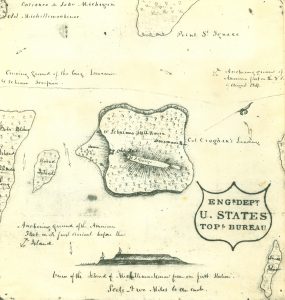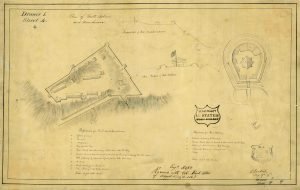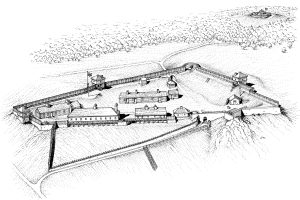
At Mackinac State Historic Parks, we are fortunate to have a huge variety of historic information available to help us protect, preserve, and present the resources under our care. Our archives and artifact collections contain numerous descriptions and depictions of the historic sites we manage, providing unique snapshots in time. A great example of these descriptive works is a report written by Lt. Col. Talbot Chambers in September 1815, soon after American troops returned to Mackinac Island following the War of 1812.

Lt. Col. Chambers of the Regiment of Riflemen took command of Fort Mackinac after the British returned Mackinac Island to the United States in July 1815. On September 10, he wrote a lengthy report to General Jacob Brown, commander of U.S. forces in the Great Lakes region, detailing the defenses of Forts Mackinac and Holmes. He described Fort Mackinac as having “a triangular form, & the basis of the work is a stone wall (but very far from being impenetrable) about three feet high, on which is erected a row of picquettes, with a block house, large enough to work a light piece of Artillery, erected at each angle of the fort.” He also noted that “the fort contains Barracks sufficient for three hundred men, with a bomb proof magazine, artificer’s shops, and depots for every necessary kind of stores.” However, Chambers had a very low opinion of Fort Mackinac thanks to its location below a commanding hill in the center of the island. He found the fort “so [poorly] constructed as to be incapable of enfilading in any direction, and composed of such slight material, that a twelve pounder would in a few minutes batter it about the ears of its defenders, without receiving the least annoyance; and on every side (save that which bears on the strait) an enemy could not fail in assuming a position, which would render us untenable even for a few hours.” Chambers felt that Fort Mackinac was such a poor defensive position that “were we solely dependent on the resistance which fort Mackinac would be enabled to make, our situation would be indeed Deplorable.”
Chambers was much more enthusiastic about Fort Holmes, the small post on the island’s highest point that British troops had built during the war. Fort Holmes was “a small, but very strong work…situated on a very Commanding site, and only accessible at one point, of an oblique shape, ditched and frized [ringed with pointed, horizontal logs], with platforms, about half completed, for eleven pieces of Cannon, containing a tolerable strong block house, large enough to work two twelve [pound cannons], and two bomb proof magazines, besides other appendages.” Chambers detailed his plans to finish the defenses at Fort Holmes, which would serve as the primary strongpoint on Mackinac Island in the event of an attack. Only a few soldiers would be left behind at Fort Mackinac while most of the men defended Fort Holmes. Once complete, Chambers felt that Fort Holmes would be so strong that “I shall not fear the best two thousand troops the Britain can send against us, even were they to be headed by a Wellington,” referring to the Duke of Wellington, who had recently crushed Napoleon’s armies at the Battle of Waterloo.

Despite Chambers’ high hopes for Fort Holmes, he also reported that his supplies were dwindling as winter approached. Much of the food supplied to his men by government contractors was spoiled, the soldiers’ uniforms were falling apart, and the troops had not been paid in months. Additionally, while visiting Native American leaders “manifest an ardent wish to cultivate a friendship with the government,” they also demanded provisions and diplomatic gifts. Chambers ended his report with a plea for Brown to examine the supply issues plaguing the Mackinac garrison, as well as to overlook the costs associated with making Fort Holmes the stronghold the colonel envisioned.
Chambers’ report provides a unique snapshot of the situation on Mackinac Island immediately after the War of 1812. The American troops found themselves occupying two forts, one all but defenseless and the other a potentially formidable stronghold, but also facing the prospect of a northern Michigan winter without sufficient food or clothing. This complex description helps us better understand and interpret the history of Fort Mackinac and Fort Holmes. We hope you’ll join us this summer to see for yourself what Lt. Col. Chambers described in 1815. Fort Mackinac and Fort Holmes open for the season on May 2, 2019.









